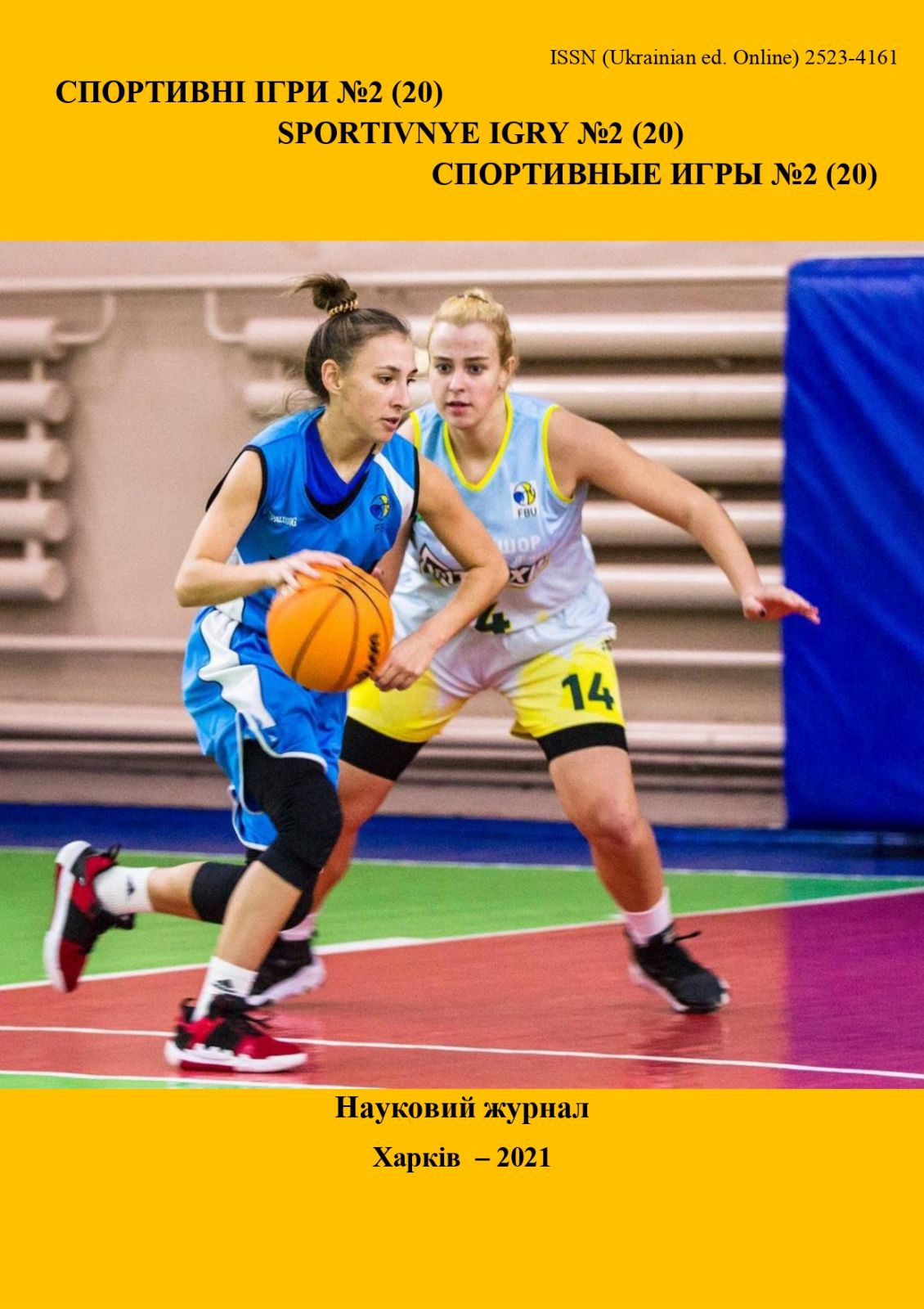Influence of means of game Ringo on a condition of cognitive processes of sixth-graders
Keywords:
ringo, physical culture, sixth-graders, cognitive processesAbstract
Relevance of research. The game of ringo, on the one hand, is
an accessible and interesting means of physical education of schoolchildren, and on the other - it is
necessary to check the effectiveness of this game on the state of cognitive processes of
schoolchildren. The purpose of the study is to determine the dynamics of indicators of cognitive
processes of sixth-graders in physical education lessons during the study of the ringo game. Study
participants. The study involved 55 students of 6 classes, the experimental group consisted of 27
children (12 boys, 15 girls), and the control group consisted of 28 students (14 boys and 14 girls).
Research methods: theoretical analysis of scientific and methodological literature, testing to assess
the state of cognitive processes (concentration, perception of time, distribution of attention, visual
memory), pedagogical experiment, methods of mathematical statistics. Research results. Analysis
of test results to determine the accuracy of time perception by students in the research groups
showed that children who studied experimentally, using the means of playing in the ringo, had
better performance than peers with CG. At the end of the experiment, the boys of EG increased
their performance in the test for stability and concentration by 22.2 c.u. and ahead of sixth-graders
CG by 9.9 c.u.. The EC girls achieved even higher results, increasing this figure by 30.1 c.u. and
surpassing the sixth-graders CG at the end of the experiment by 13.2 c.u. (р<0.05). During the
experiment, positive changes were obtained in terms of visual memory. At the end of the experiment,
EG students were ahead of CG children (р<0.05) in the number of visual memory assessment
scores. The difference in the distribution of attention between students of CG and EG at the end of
the experiment in boys was 1.9 c.u. (р<0.05), and girls 2.5 c.u. (р<0.05). Conclusion. Analysis of
the results of psychological tests of sixth-graders in the experimental classes showed that children
who studied experimental technology were ahead of their CG peers in tests to determine the
stability and concentration of attention, visual memory, attention distribution and time perception.
Therefore, it can be argued that the proposed technology of learning to play the ringo helps to
improve the performance of cognitive processes.
References
Вітвицька, С.С. (2003). Основи педагогіки вищої школи: Методичний посібник для студентів магістратури. Київ: Цент навчальної літератури.
Кікінежді, О.М., Сіткар, В.І., Степанов, О.М., Хмурич, Р.М., Юрківський, Є.В. (2000). Практикум з курсу «Загальна психологія». Тернопіль : бр.
Круцевич, Т.Ю., Воробйов, М.І., & Безверхня, Г.В. (2011). Контроль у фізичному вихованні дітей, підлітків і молоді. К. : Олімп. л-ра.
Лаврін, Г.З. (2016). Способи та прийоми підвищення цікавості занять з фізичного виховання у ВНЗ. VIRTUS, 6, 146-150.
Лаврін, Г.З., & Кучер, Т.В. (2009). Рінго – ефективний засіб фізичного виховання cтудентської молоді. Інноваційні підходи до фізичного виховання і спорту
студентської молоді. Тернопіль: ТНПУ ім. В. Гнатюка.
Лаврін, Г.З., & Середа, І.О. (2019). Реалізація завдань професійно-прикладної фізичної підготовки студентів педагогічних вузів засобами гри в рінго. Спортивні ігри, 1(11), 16-23. doi.org/10.5281/zenodo.2543540
Лаврін, Г.З., & Середа, І.О. (2020). Результати опитування студентів, щодо ефективності застосування засобів гри рінго у процесі фізичного виховання. Спортивні ігри, 1(15), 25-33. doi: 10.15391/si.2020-1.03
Марищук, В.А., Блудов, Ю.М., Плахтиенко, В.А., & Серова Л.К. (1990). Методики психодиагностики в спорте: Учеб. пособие для студентов пед. ин-тов по спец.
физическая культура – 2-е изд., доп. и испр. М.: Просвещение.
Мурза, В.П., & Філіппов, М.М. (2001). Методи функціональних досліджень у фізичній реабілітації та спортивній медицині. К. : університет "Україна".
Помещикова, І., Кудімова, О., Цеслицка, М., & Мушкета, Р. (2018). Периферійний зір баскетболістів 16 років. Спортивні ігри, 1(7), 29-34.
Стефанов, В. Ринго в «Русской гимназии». – [Електронний ресурс]. – Режим доступу: http://ringo.org.pl/irf/images/referat/ringo_w_rosji.pdf.
Anioł-Strzyżewska, K. (2010). Ringo–jeszcze jedna pasja sportowo-organizacyjna prof. W. Starosty.[W:] Kariera naukowa czy pasja życia.
Lavrin, H., Sereda, I., Kucher, T., Grygus, I., Cieślicka, M., Napierała, M., Muszkieta, R. & Zukow, W. (2019). Efficiency Means the Game Ringo the Classroom Physical
Education. International Journal of Applied Exercise Physiology, 8,3 (Sep. 2019), 8-15. doi: 10.26655/IJAEP.2019.9.2
Starosta, W., & Strzyżewski, W. (2010). Ringo – polska gra sportowa dla każdego. (Historia, technika, metodyka, taktyka, wyniki, przepisy). – [Електронний ресурс]. – Режим доступу: http://www.ringo.org.pl/index.php/o-ringo/ringo-polska-gra-sportowa Starosta, W. (2006). Poziom koordynacji ruchowej i skoczności uprawiających ringo.[W:] Globalna i lokalna koordynacja ruchowa w wychowaniu fizycznym i sporcie (W. Starosty). Międzynarodowe Stowarzyszenie Motoryki Sportowej, 19, 326-333.
Starosta W, & Wangryn M. Ringo – Polish Sports Game for Everybody. – [Електронний ресурс]. – Режим доступу: http://irf.ringo.org.pl/index.php/game-rules/ringo-polish-sports-gamefor-everybody. Starosta, W., & Wangryn, M. (2012). ABC polskiej gry w ringo (Metodyka nauczania techniki i taktyki)[ABC of Polish ringo game (Methodology of technique and tactic teaching and improvement). Międzynarodowe Stowarzyszenie Motoryki Sportowej. Polskie Towarzystwo Ringo. Warszawa, 36, 146.
Strybel, R. (2009). Polish-Originated Sport For Fun, Fitness. Sat, Nov, 21. – [Електронний ресурс]. – Режим доступу: http://ampoleagle.com/polishoriginated-sport-for-fun-fitnessp1809-179.htm Strzyżewski, W. (1979). Popularization of Ringo as a Method of Movement-, Health-and Recreation Education. [In:] Sporterziechung und Evaluation. Schriftenreihe des Bundesinstitut fur Sportwissenschaft, Verlag Karl Hofmann, Schorndorf, Band, 6, 132-136.













